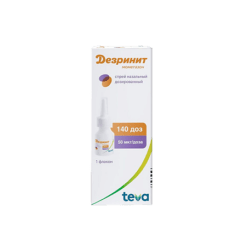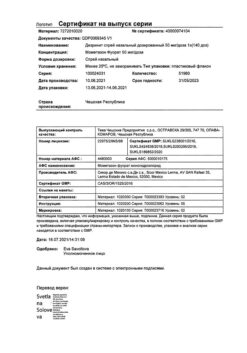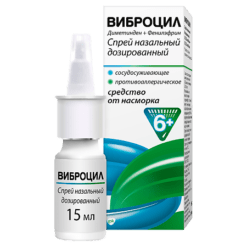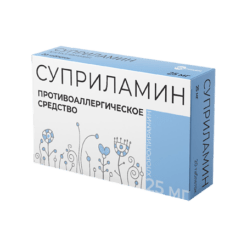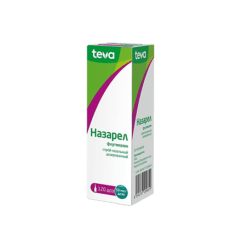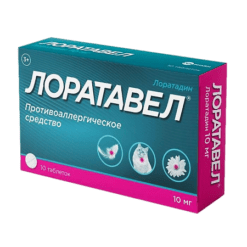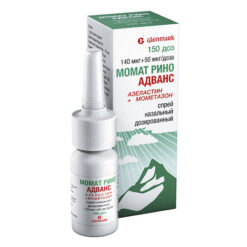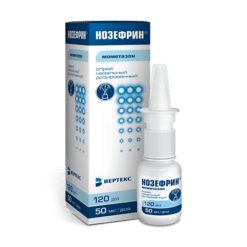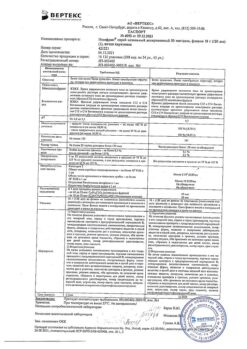No products in the cart.
Colistin, for inhalation 80 mg (1000000 units) 28 pcs
€1.00
Out of stock
(E-mail when Stock is available)
Description
The antibiotic is polypeptide cyclic. Colistimethate sodium is formed by Bacillus polymyxa, subspecies colistinus. Colistimethate is a methanesulfonate of colistin.
Sodium colistimethate has a bactericidal effect on Gram-negative microorganisms in the stage of division and resting by changing the structure and function of the outer and cytoplasmic membrane.
The drug is active against Pseudomonas aeruginosa, Haemophilus influenzae, Acinetobacter spp., Citrobacter spp., Enterobacter spp., Klebsiella spp., Salmonella spp., Shigella spp.
Not active against Burkholderia cepacia and Staphylococcus aureus. Caution is required when determining the sensitivity or resistance of pathogens when using colistimethate sodium by inhalation.
Indications
Indications
Treatment of respiratory tract infections caused by Pseudomonas aeruginosa in cystic fibrosis.
Pharmacological effect
Pharmacological effect
Cyclic polypeptide antibiotic. Sodium colistimethate is produced by Bacillus polymyxa, subspecies colistinus. Colistimethate is colistin methanesulfonate.
Sodium colistimethate has a bactericidal effect on gram-negative microorganisms that are in the stage of division and dormancy, by changing the structure and function of the outer and cytoplasmic membrane.
The drug is active against Pseudomonas aeruginosa, Haemophilus influenzae, Acinetobacter spp., Citrobacter spp., Enterobacter spp., Klebsiella spp., Salmonella spp., Shigella spp.
Not active against Burkholderia cepacia and Staphylococcus aureus. Caution is required when determining the sensitivity or resistance of pathogens when using colistimethate sodium by inhalation.
Special instructions
Special instructions
Inhaled drugs, incl. Colistin may cause acute bronchoconstriction in sensitive patients. Therefore, the use of the first dose of Colistin for inhalation should be carried out under the supervision of experienced medical personnel, and inhalation should be preceded by the use of a bronchodilator, if it is included in the treatment regimen of this patient.
Before and after inhalation of Colistin, FEV should be measured in 1 second. If a patient not receiving bronchodilators has signs of drug-induced bronchial obstruction, the next time Colistin is used, the test should be repeated by adding a bronchodilator.
The first use of Colistin should be carried out under the supervision of medical personnel experienced in working with patients suffering from cystic fibrosis.
Patients with impaired renal function should be closely monitored for the possibility of side effects from the nervous system and renal function should be regularly monitored.
It is necessary to take a break between dornase alfa inhalation and Colistin inhalation.
In rare cases, treatment with Colistin may result in the emergence of resistant strains of Pseudomonas aeruginosa. After discontinuation and/or modification of therapy, the effectiveness of the drug may be restored.
During treatment with the drug, the patient should refrain from drinking alcohol.
Impact on the ability to drive vehicles and operate machinery
During the treatment period, it is necessary to refrain from driving vehicles and engaging in potentially hazardous activities that require increased concentration and speed of psychomotor reactions.
Rules for using the drug
1. The bottle of powder is opened by removing the aluminum cap, checking the first opening and opening the rubber stopper.
2. The ampoule with the solvent is opened using a file or device for opening ampoules.
3. The contents of the ampoule are completely poured into a bottle with powder. The powder dissolves with gentle shaking. Vigorous shaking should be avoided due to excessive foam formation.
4. The solution is poured into a nebulizer and used by inhalation according to the nebulizer manufacturer’s instructions.
5. The patient performs the Colistin inhalation procedure in a sitting or standing position, in a normal calm state, taking as deep breaths as possible through the mouthpiece of the nebulizer. Using a nose clip can make breathing through your mouth easier.
6. After each use, the inhaler should be washed and disinfected, following the manufacturer’s instructions.
In patients receiving other types of inhaled therapy, inhaled use of Colistin should be carried out immediately after the use of a bronchodilator, as well as after physiotherapeutic procedures on the chest.
Active ingredient
Active ingredient
Colistimethate sodium
Composition
Composition
1 fl.
colistimethate sodium
1 million units (80 mg)
Solvent: sodium chloride solution 0.9% – 3 ml.
Pregnancy
Pregnancy
Due to the risk of developing nephro- and neurotoxic reactions in the fetus, Colistin should be used during pregnancy under medical supervision with caution and only for health reasons.
If it is necessary to use Colistin during lactation, breastfeeding should be discontinued.
Contraindications
Contraindications
Children under 6 years of age;
hypersensitivity to the components of the drug.
The drug should be used with caution in case of bronchial asthma, impaired renal function, hemoptysis, and pregnancy.
Side Effects
Side Effects
Allergic reactions: angioedema.
From the central nervous system and peripheral nervous system: dizziness, paresthesia.
From the respiratory system: bronchospasm (>10%), increased cough, increased sputum production, mucositis (inflammation of the mucous membrane of the respiratory tract), pharyngitis, shortness of breath.
From the digestive system: nausea, heartburn.
From the urinary system: acute renal failure.
Interaction
Interaction
When colistin is used with inhaled anesthetics (ether, halothane), muscle relaxants or curare-like drugs (tubocurarine, succinylcholine) or aminoglycosides, the possibility of developing neurotoxic reactions should be carefully monitored.
When Colistin is used simultaneously with potentially nephrotoxic drugs (aminoglycosides, cephalosporins, cyclosporine), nephrotoxicity may increase.
Pharmaceutical interactions
The prepared Colistin solution should not be mixed with other medications.
Overdose
Overdose
Symptoms: from the central nervous system and peripheral nervous system – dizziness, paresthesia, diplopia (due to paresis of the eye muscles), ptosis, general weakness, speech impairment, areflexia, visual impairment, dysphagia, convulsions and coma; neuromuscular blockade can cause death due to respiratory paralysis; from the urinary system – damage to the epithelial cells of the renal tubules and necrosis of the tubules.
Treatment: symptomatic therapy, peritoneal dialysis (or hemodialysis) is advisable; Ventilation Calcium gluconate and neostigmine do not relieve neuromuscular blockade.
Manufacturer
Manufacturer
Xellia Pharmaceuticals ApS, Denmark
Additional information
| Manufacturer | Xellia Pharmaceuticals APS, Denmark |
|---|---|
| Medication form | Powder for preparation of solution for inhalation |
| Brand | Xellia Pharmaceuticals APS |
Related products
Buy Colistin, for inhalation 80 mg (1000000 units) 28 pcs with delivery to USA, UK, Europe and over 120 other countries.


